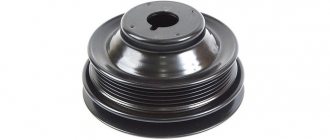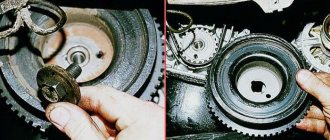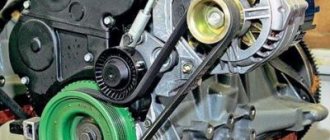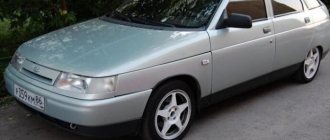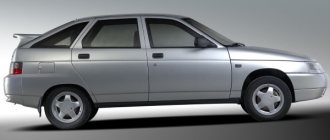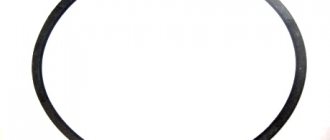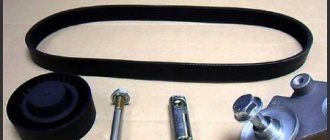A car generator is an important component in the system of any car and it ensures its correct operation. Given the fact that it consists of many elements, of course it breaks sometimes. Its malfunction negatively affects the entire operation of the car, since it is impossible to start the car without it. There may be several reasons why it breaks. We will consider one of them in this article. The cause of the malfunction may well be the pulley. In this article I will talk about the main causes of failure and how they affect the performance of the unit. Let's figure out how to remove the pulley from the generator and, if necessary, repair it.
Reasons for dismantling the crankshaft
Dismantling the crankshaft on a VAZ-2114 may be required in the following cases:
- The reason that comes first is most often the replacement of the timing belt and other work that is somehow related to the gas distribution mechanism. Work should be carried out in accordance with the regulations, or if the mechanism fails.
- Another reason for dismantling is the failure of the crankshaft oil seals. They are changed when oil leaks occur in the places where they are installed.
Pulley fastening
On all VAZ-2114 vehicles without exception, the crankshaft pulley is fixed using a massive bolt, which can cause problems when removed.
A curved spanner wrench is good for fixing.
- First of all, this is due to its location, since it is difficult to securely and securely fasten the key or socket head.
- Secondly, even if you managed to position the key correctly, you will have to make every effort to dismantle it . This is due to the fact that at the factory it is tightened as tightly as possible in order to avoid the facts of self-unwinding. Also, the right-hand thread may not be the best for unscrewing it, which during operation only screws the pulley in tighter and causes the part to stick.
When performing work to remove it, it is best to keep WD-40 on hand.
Tool for getting the job done
To make the work easier, you need to prepare the following tool:
- Jack.
- Wheel chocks.
- Pry bar and flat blade screwdrivers.
- A set of keys.
- Socket heads and extension.
It is best to carry out such work on a lift or inspection pit.
VESKO-TRANS.RU
AutoNews / Reviews / Tests
How to Remove the Generator VAZ 2112 16 Valves
We change the alternator belt on a VAZ 2112 ourselves
The belt drive powers the generator to generate electricity in the vehicle. The device can work normally according to the criteria that remains for our client; its components are useful. This also applies to the strap. Replacing a VAZ 2112 alternator belt with 16 valves is not a complicated procedure that can be done in the garage. A detailed summary and video article will help with this.
When is replacement required?
Like any consumables, the alternator belt has a certain resource and requires constant technical inspection. According to the manufacturer's advice, VAZ 2112
Regardless of whether the engine has 16 valves or 8, it is necessary to change consumables after 45 thousand km. But these are just tips, you need to constantly worry about the condition of the product and just change it correctly. The service life depends on the following reasons:
driving style; performance criterion; product properties.
A visual inspection of the drive units should be carried out when the vehicle has driven a maximum of 10,000 km and before a long journey. This allows you to avoid unpleasant surprises from the trip - a torn belt. It is recommended to carry a spare in the trunk without assistance, because when a break occurs, the car will no longer be able to move without assistance.
It is necessary to change the belt if it breaks, stretches, as it is called, or becomes unusable. Poor voltage detection is a variant of a specific whistle that occurs when the engine starts. Tension plays an important role in belt drive performance. When the voltage is low, the device does not produce the amount of electricity required for the vehicle to operate properly. If it is strong, the service life of the belt, drive bearings and crankshaft is shortened.
Find a replacement, of course, if you look at the following:
- the appearance of cracks and ruptures;
- worn surface;
Old product with worn surface
material delamination; frayed edges; strong stretch. Belt tension is easy to check. This is considered normal if, with a force of 10 kg, it bends by 10-15 mm. To test, he needs to press his thumb into the center of the belt between the crankshaft pulley and the alternator.
Step-by-step procedure for removing the crankshaft pulley on a VAZ-2114
Before you begin dismantling the crankshaft pulley, you need to unscrew some components and parts on the VAZ-2114.
- First of all, we park the car and ensure it is stationary.
- Next, loosen the generator belt tension bolt and completely remove the locking bolt.
All bolts are indicated by red arrows.
Insert the screwdriver into the hole indicated by the mark.
When the flywheel is secured, you can proceed to dismantling the crankshaft pulley.
The marks are indicated by red arrows.
This work should be carried out very carefully.
It is more convenient to pry off the crankshaft using a pry bar.
conclusions
After the pulley has been removed, you can begin installing a new part, before installing which the seat will need to be lubricated with grease. At this point, the work can be considered completed.
How to change (remove and install) a car's electric generator belt pulley. Detailed instructions. Subtleties and features. Personal experience (10+)
Replacing a car alternator pulley
Replacing a car generator pulley in a home workshop is quite possible. To do this, you only need an available tool.
The generator pulley should not be clamped in a vice, as it can easily be deformed. You will need a special (rather simple) homemade device.
After installing the pulley, you need to take care to securely fix the nut so that it does not unscrew.
In the previous article, I wrote how to choose a suitable analogue of the original generator. In particular, it often happens that the generator as a whole fits, but the pulley
designed for a different belt. The pulley can be narrower (designed for a poly V-belt with fewer ribs), wider (designed for a poly V-belt with a larger number of ribs), or even designed for a belt of a different design.
We put a narrower belt
In the first two cases, this solution can be applied. A narrower belt is installed. If the generator pulley is designed for, say, 6 wedges, and the engine shaft pulley is designed for 5, then we take a five-ribbed belt; if the generator pulley is designed for 4 wedges, and the engine pulley for 5, then we take a four-ribbed belt. In general, we take the smaller number of clients on the generator and on the engine shaft. Then part of the larger pulley (or pulleys, since there may be several of them, for example, a pump pulley) will remain free. Nothing wrong with that. Based on my experience, I can say that such a belt runs normally. You just have to change it more often.
Remove the pulley
If the pulley is generally designed for a different type of belt, then the pulley needs to be replaced
. And in the first two cases, it is better to replace the pulley and install a standard belt.
The pulley itself can be purchased separately or removed from a faulty generator that was previously installed. The pulley practically does not wear out.
The main difficulty with replacement is that the clamping nut is tightly screwed and riveted. It needs to be unscrewed, but the pulley cannot be clamped, since it is made of a soft alloy and can easily bend. The problem is getting it to stick. In handicraft conditions it is solved this way.
To begin, spray the nut of the electric generator with VDeshka. This must be done carefully so that it does not fall on the working surface of the pulley. Let it soak overnight.
Next you will need two strong, well-fixed pins. We take a strong, thick, non-stretchy rope. We wrap it around the pins and tie it with a reliable sea knot, for example, a figure eight. It’s even safer to take the same strong, non-stretchy rope, but thinner, and wind it several turns, then tie the ends. So we have a rope ring around the pins. We insert the generator pulley into this ring. Rotate the generator housing so that the rope on the sides is twisted.
Varieties of design
Classic pulleys are secured to the shafts with keys. However, this type of fastening is practically unsuitable for frequently changing and alternating loads - the key is cut off or the seating groove is broken, backlash appears, so the generator pulley is put on the shaft without tension, Morse tapers and keys, and is pressed with a nut.
Fastening the pulley with a clamping nut
This method ensures no spinning even at maximum speed, taking into account that the shaft diameter is 17 mm, the nut thread is M16, and the steel/steel friction coefficient is 0.15 units.
The nut must be tightened with a force of 40 - 50 Nm in two stages - up to 20 Nm, then tightened to an angle of 70 degrees.
Attention: The threaded connection of this unit is self-tightening, therefore engraving washers, nuts with polymer liners and capping of ordinary nuts are prohibited. When using these techniques, the pulleys, on the contrary, are unscrewed and rotated on the shaft.
The problems are completely solved by the inertial pulley of the generator - an overrunning clutch of the following design:
- the outer race copies the pulley, has grooves for V-belt or poly-V-belt transmission, the same outer diameter as a regular pulley;
- the inner race is a bushing that fits onto the generator shaft;
- A damper rubber layer, a spring and a roller bearing of a special design are installed between the clips.
Overrunning clutch design
This scheme makes it possible to smooth out the crankshaft rotation pulses due to the inconsistent coupling of the races with each other. During sharp acceleration, the outer race smoothly catches up with the inner sleeve. When braking, on the contrary, the inner race equalizes the angular velocity relative to the outer pulley.
A special tool has been created for installing and dismantling overrunning clutches, analogues of which can be made on your own much cheaper.
We install a new one
There are usually no problems with installation. It is only important to remove all traces of VDeshka (rinse with gasoline or acetone) and securely fix the nut so that it does not unscrew. You should not rivet it, as at home you can bend or damage something. I wrap it around paint or varnish. Read also about other ways to fix a threaded connection. When we tighten the nut, we fix the pulley in the same way as when unscrewing.
Unfortunately, errors are periodically found in articles; they are corrected, articles are supplemented, developed, and new ones are prepared. Subscribe to the news to stay informed.
If something is unclear, be sure to ask! Ask a Question. Discussion of the article.
Carburetor. Device. Operating principle. Advantages. Advantages. N. Design and principle of operation of the carburetor of an internal combustion engine.
Do-it-yourself electrical installation work. Tool, wire stripping, . Carrying out electrical, electrical, electrical installation work with your own.
Explanatory notes - examples, templates, samples. Explanatory letter. Sample. Correct structure, instructions, explanations.
How to hammer a nail into a knot. You really need to hammer a nail into a knot, how to do this.
Reasons for the flame going out, the stove burning weakly or too hotly. Review of kitchen gas stove malfunctions. Weak or too strong combustion.
Hydraulic level - choosing the right one when purchasing. How to choose a proper building level. There are a lot of defects on sale. How not.
Gas stove. Conversion to natural / liquefied, bottled gas. Stop. How to convert a kitchen gas stove to another gas, swap burners, for.
How to ensure electrical wiring safety? How to install machines and... How to ensure electrical wiring safety? Automation. Electric automatic machine, .
Renault Megane › Logbook › Replacing generator bearings and installing generator pulley 2110
AHTUNG! IT IS NOT RECOMMENDED TO REPLACE THE ORIGINAL PULLEY WITH A VAZ PULLEY! (except to wait 100 km before the service) DUE TO THE ABSENCE OF AN OVERAGGING CLUTCH, THE BELT WILL OCCUR AND DESTRUCTION, WITH THE CONSEQUENTIAL TIGHTENING OF THE FRAGMENTS UNDER THE TIMING DRIVE SPROCK
This means that the rustling noise from under the hood completely bothered me, I even began to suspect the release valve... However, the smell of burnt rubber in traffic jams convinced me to turn my attention to the generator, its bearings and pulley. I took off the belt of the additional equipment and pronounced the verdict - generator bearings. It was lunch time, I removed the generator, brought it to the workshop and began to disassemble it. I’ll say right away, the generator is BOSCH.
The first obstacle was removing the pulley from the generator shaft. During creative searches, the following device was invented:
A 27mm nut is inserted inside the nut, then a 8mm hexagon is inserted into the shaft, the hexagon is held with a wrench or socket, and the nut is turned counterclockwise and unscrewed in this way. In this case, the generator must be gently clamped in a vice (and not as in my picture). The nut is unscrewed and the pulley is removed. During this procedure, I realized that I had also hit the pulley. Because it had a lot of play in the radial plane, and touched the generator housing, even rubbing small grooves from below.
Next comes the disassembly of the generator, unscrew everything that can be unscrewed from below (or behind) - positive contacts, cover, diode bridge, relay regulator with brushes, removed and placed nearby. Although actually it is not a relay as such, but a circuit with 3 transistors, but for brevity, let it be the old-fashioned relay regulator.
Next, the 4 bolts holding the generator halves together are unscrewed, and the lower (rear) part with the diode bridge is removed from the rotor. You can help yourself a little with a screwdriver, there is some force there, but not much.
Next you need to unscrew the 4 countersunk screws from the pulley side. They secure the front bearing thrust plate. After this, we take a three-legged puller of a suitable size, grab it under the front cover with its paws, rest against the shaft, and pull the cover off the bearing.
After this we will have a picture like this
The main problem was removing the front bearing. On top of it there is a spacer washer, quite rusty. It was impossible to get under it with a puller; it wouldn’t fit together with the bearing, so I had to carefully knock it down. Unfortunately, there are no photographs of this process, because at this point the phone was put on charge, but I will try to describe it in words. I poured WD40 liquid on it and turned it on the shaft a couple of turns using a chisel. The anchor is GENTLY clamped in a vice through the old belt. Next, I drove a chisel between the washer and the bearing, evenly and from different sides, until the washer began to move towards removal. Then I hooked it up with a puller and removed it. The bearing did not yield to the puller and was barbarously sawed off with a cutting machine, without however damaging the shaft. The sawn-off bearing came off easily.
Now you can start assembling.
The bearing is pressed into place from the inside of the front cover of the generator with a suitable mandrel onto the outer ring of the cage by lightly tapping it with a hammer, and the bearing cover is put in place. I wanted to install the cover from the repair kit, but it didn’t fit, and it was kind of flimsy.
Replacing crankshaft liners VAZ-2107
Remove the hood and battery
Drain the oil from the engine (see Changing the VAZ-2107 engine oil).
Drain the coolant (see Replacing the coolant in a VAZ-2107).
We remove the radiator together with the thermostat (see VAZ-2107 radiator replacement).
Remove the carburetor (see Replacing the VAZ-2107 carburetor).
Remove the fuel pump.
Remove the ignition distributor (see Ignition distributor VAZ-2107 repair).
Having sketched the connection order, disconnect the hoses and wires from the engine.
To make it easier to dismantle the engine, remove the cylinder head (see Replacing the VAZ-2107 head gasket).
Remove the coolant pump (see Replacing the VAZ-2107 coolant pump).
We unscrew the upper or lower nuts securing the engine mount (see Replacing the VAZ-2107 engine mount).
We unscrew the bolts securing the clutch housing to the engine.
1. Fasten the lifting device cables to the block and lift it.
By placing a jack under the gearbox and slightly rocking the block, we disconnect the engine and clutch housing.
We install the cylinder block on the stand.
We remove the clutch. Remove the pulley, camshaft drive cover, chain and oil pump drive gear. Remove the auxiliary drive shaft.
Remove the flywheel and the rear crankshaft cuff holder (see Replacing the rear crankshaft cuff).
2. Using a 10mm wrench, unscrew the fourteen bolts securing the oil pan to the cylinder block...
3...and remove it along with the sealing gasket. We remove the oil pump (see Oil pump removal and disassembly VAZ-2107)
Using a 14mm socket, unscrew the two nuts securing the connecting rod cover
Using the wooden handle of the hammer against the connecting rod, we push the piston out of the cylinder.
Similarly, remove the remaining three pistons.
Using a 17mm socket, unscrew the two bolts securing the crankshaft main bearing cover...
In the same way, remove the remaining four main bearing caps.
They are marked with marks corresponding to their serial number (count from the toe of the crankshaft).
On the last (fifth) cover there are two marks stamped, spaced along the edges.
Marks on the main bearing caps
We remove the crankshaft.
From the grooves in the bed of the fifth main bearing, we remove two half rings of the crankshaft thrust bearing.
The steel-aluminum liners installed in the beds of the 1st, 2nd, 4th and 5th main bearings have a groove.
The shell of the 3rd bearing does not have a groove (similar to the shells installed in the main bearing caps).
We disassemble the crankshaft (see Disassembling the crankshaft of a VAZ-2107).
What can a faulty pulley cause?
First, you need to understand the reasons for the breakdown of this element in order to protect the car owner from unplanned repairs. Breakage can occur even from a small blow; this is due to the fact that during production this part, as well as its inner ring, was not hardened. And this makes them quite fragile. It is entirely possible that it can be destroyed by the presence of even the most insignificant free movement. Therefore, it needs to be well strengthened during installation. During the production process of this element, micro scratches are formed on its surface. These scratches can grow over time, causing the part to malfunction and requiring replacement.
Generator pulley
The generator pulley occupies an important place in the design of the car. Let's find out why it is needed? What malfunctions are typical for the pulley, how to change it and repair it? Every driver should know about this, since taking care of such things dramatically increases the smooth operation of the engine.
Why do you need a generator pulley?
The generator pulley is installed on the rotor shaft and is designed to drive the generator. The pulley receives torque from the crankshaft pulley through a belt drive.
In addition to its main function, the pulley also protects the generator. During operation, the crankshaft generates vibrations that can negatively affect the operation of the generator. The pulley plays the role of a vibration damper and, thereby, protects the generator from adverse influences.
In addition, the alternator pulley reduces the load on the engine when the speed is too high and ensures reliable battery charging.
Working principle and benefits of overrunning clutch
The generator, which is the source of electricity, is driven by an internal combustion engine, but since the engine operates at different speeds, its torque is constantly changing. The generator armature (rotor), driven by the internal combustion engine, rotates by inertia and when changing mode continues to rotate in the same rhythm, therefore the load on the belt at these moments increases significantly. An overrunning clutch (another name is an inertia pulley) is designed to smooth out differences in torque; this mechanism works on the Bendix principle in a starter. When the engine picks up speed, the parts of the overrunning clutch are engaged with each other, providing a rigid connection and maximum transmission of motion.
At first, inertial pulleys were installed only on diesel engines, but later they also appeared on premium cars with powerful gasoline engines. Now such devices can be found on many car models, for example, Ford Transit or Ssang Yong Chiron with diesel engines, and are no longer uncommon.
Why does the pulley become unusable?
Such a pulley, although made of metal, fails quite often. As a result, the generator stops rotating and the battery does not charge. To prevent this from happening, you need to be well aware of all the factors affecting the serviceability of the pulley.
The metal from which the generator pulley is made is not hardened. This makes it a fragile element for which various mechanical impacts are not desirable. These may include impacts and poor fastening tightening. If, during installation, the fastening does not provide a reliable connection between the shaft and the pulley, then play will appear, which will create vibrations throughout the entire structure of the part. They lead to the appearance of cracks, which sooner or later simply breaks the pulley in half. In addition, such vibrations negatively affect the generator rotor, which will lose its balancing and begin to short its poles to the stator steel.
Functions
VAZ 2110 pulley unscrewed in the generator
A faulty pulley leads to various generator malfunctions, since it performs the following important functions:
- Firstly, it is a kind of generator protection. While the car is moving, the crankshaft is also in constant motion. This leads to small fluctuations being formed. Acting on the generator, such vibrations would lead to its breakdown. Fortunately, the pulley carefully protects him from this.
Note: this element is completely stationary. Despite this, it affects all components of the generator.
- In particular, thanks to it, even the belt stops oscillating with the previous force.
- The belt stretches less, so it will function longer. Therefore, if the pulley is not replaced in time, the belt may break.
- The belt drive is much quieter.
- The pulley is capable of unloading the generator at high speeds. In this case, less load will be placed on the engine.
- By using a good pulley, the battery will not drain too quickly. Therefore, the car will work longer.
- By changing the generator pulley, the gear ratio will also change. As a result, at idle the generator will spin much slower, so it will not produce anything, and gasoline consumption, among other things, will be significantly less.
DIY alternator pulley replacement
The pulley is replaced after the above faults are detected. At the same time, this procedure can be performed both with the generator removed and installed. The choice of solution depends on the design of the car. There are models in which it is difficult to replace the pulley due to too little space. Because of this, you need to remove the generator.
Procedure:
1. Open the hood of the car and remove the terminal from the battery. Try to always perform this action, since when working under the hood there is a risk of accidentally shorting something. Short circuits are known to adversely affect the battery.
2. Unscrew the nut on the generator adjustment bar and loosen it from below. After this, move the alternator to the side of the engine and remove the alternator belt so that it is out of the way.
For owners of cars with automatic transmission
How to unscrew the crankshaft pulley on an automatic machine? If an automatic gearbox is installed, then on a rear-wheel drive vehicle the “Parking” gear is set. The handbrake is turned on and then the element is unscrewed in the same way as on a manual gearbox. It is more difficult if the car is front-wheel drive. In this case, it will not be possible to remove the element as if it were a manual transmission (with the gear engaged and the brake pressed).
There is a high risk of damaging the gearbox. In this case, you need to lock the crankshaft so that it cannot rotate in any other way. Insert the assembly between the teeth of the engine flywheel ring gear through the hole in the gearbox bell. It is supported so that it cannot jump off and damage the teeth on the flywheel. In some cases, to get to the flywheel, you need to unscrew the engine starter. To do this, you will need an inspection hole, a lift or an overpass.
Generator pulley repair
To repair a damaged pulley, you must remove the generator. The range of repair work is extremely limited, as it involves the elimination of minor and minor faults.
1. If there is play in the fastening, then it is necessary to tighten the connection. This operation is only possible if there is a slight fluctuation. If the pulley is completely loose, it is replaced with a new one.
2. If a protective cover is provided on the pulley, it must be replaced if it fails. Never operate the alternator pulley without the protective cover provided.
3. Small cracks on the pulley can be sealed. In case of formation of thick fracture lines, only replacement is allowed.
Only if these faults are present can the generator pulley be repaired. In all other cases, only replacement is allowed.
That's probably all you need to know about the generator pulley. Try to pay a lot of attention to this part, as its breakdown can lead to battery discharge and further immobilization of the car.
If you are faced with the problem of how to unscrew the crankshaft pulley bolt, this article is for you. We will describe this process in detail so that you can quickly and easily remove the crankshaft pulley and then begin repairing it.
Possible malfunctions and ways to eliminate them
The need to repair a generator unit may arise for various reasons. As practice shows, the most common of them are failed brushes or bearings. Read below about repairing these components.
Brush replacement procedure
Replacement of VAZ generator brushes is carried out as follows:
- First of all, you need to release the three latches on the device’s body, on its sides. These latches secure the cover to the mechanism.
- The cover itself can be detached and put aside. This will allow you to access the regulator.
- There are two bolts on the regulator that secure the device - they need to be unscrewed. Then pull the regulator and remove it.
- Assess the condition of the brushes - if they are working, then the length of these elements should be at least 0.5 cm. If their size is smaller, then you have two options - either repair it by replacing the brushes, or change the device assembly. If repairs are being made, you will need a soldering iron since the brush assembly is soldered to the relay. First, you need to unsolder the wires connected to the brushes, and then dismantle the assembly, replacing it with a new one and securely soldering it to the relay contacts. Or you simply change the relay, and further assemble the device in the reverse order (the author of the video is the IZO channel)))LENTA).
How to change bearings yourself?
To replace the bearings, follow these steps:
- On the dismantled generator, you need to block the rotor; to do this, use a screwdriver, then unscrew the pulley.
- Next, by pulling the latches, you need to remove the device casing. You need to make marks on the two halves of the case, and then, using a screwdriver, you will need to remove the front cover.
- Then you will need to knock the bearing out of its seat; to do this, you will need to place it on a more suitable object. Alternatively, you can use a 27mm socket.
- After this, you can take a new bearing device and fill it with grease. This element should be hammered through the old one. To make the device more securely fixed at the installation site, you can use a chisel to flare the edges.
- Now let's move on to the rear bearing. To do this, you need to place either a thick screwdriver or a thin chisel under it, and hit the top several times with a hammer, while simultaneously moving the screwdriver in the opposite direction. The device can be dismantled using an open-end wrench.
How to remove a crankshaft pulley bolt: why is everything so complicated?
A knowledgeable motorist usually spends no more than a quarter of an hour on the process of dismantling the crankshaft pulley. But inexperienced drivers, when trying to remove this part on their own, are faced with many problems that they often simply cannot solve. The instructions for carrying out repair work and maintenance of any modern vehicle contain comprehensive information about the dismantling process, but, unfortunately, it does not help car enthusiasts.
First of all, difficulties arise with fixing the crankshaft. It is very difficult to dismantle it if the part is constantly rotating, “slipping” out of your hands. It is also not clear to many from which side to approach the bolt that holds the pulley. And its strong tightening usually makes the process of removing the unit very, very difficult, since dismantling under such conditions is fraught with damage to the body covering or elements of the car’s engine compartment.
All car manufacturers and car service specialists use great force to tighten the nut or bolt of the crankshaft pulley (on some vehicle models the mechanism is supported by a bolt, in others by a nut).
This is done specifically to avoid self-unwinding of this part during vehicle operation. If a bolt (nut) falls out while driving, it will not be easy to bring the car back to life in order to continue driving it, and the repair itself will cost, believe me, a pretty penny. In addition, the described fasteners increase their tightening level independently when the engine is running. And the final “indestructibility” of the bolt is given by the phenomena of coking, sticking, and corrosion.
Classic methods
Essentially, standard dismantling methods involve two main methods.
You will need:
- jack to remove the wheel
- tool kit
- hydraulic jack to lift the engine, or replacing it with a “stump”
First way
In the first case, we will have to make significant physical efforts, therefore, you need to clearly focus on your own strength. We are talking about the need to put stones or special stops under the wheels that would not allow them to move during operation. The gearbox should, if possible, be set to maximum gear. The higher it is, the easier it will be for you to cope with the task. In third and lower gears, it will be almost impossible to make a turn with your hands. But everything is unscrewed by hand. To make this task easier for yourself, it is appropriate to use a lever that will reduce the necessary effort. In some cases, the length of the lever can reach one and a half meters.
Getting to the bolt is not always easy
Second way
As for the second method, it involves placing the vehicle in neutral gear. Next, you need to install a suitable sized head on the bolt with a piece of pipe, which, in turn, rests on asphalt or concrete. Ordinary soil will not be able to hold it. But the bolt itself is already loosened by the starter.
This saves a lot of effort and makes it possible to complete the task the first time. The main thing is to take into account the reliable fixation of the pipe so that it does not jump out and damage anything around it.
Be careful not to lose the pulley key
But, in any case, the threads in this nut are correct, so you need to unscrew it counterclockwise, with some exceptions, which we will now look at.
How to unscrew the crankshaft pulley bolt - solving the problem
The pulleys of front-wheel drive cars are usually secured with a bolt. In such vehicles, the pulley is oriented perpendicular to the axis of the machine, which, of course, complicates repair work (it is very difficult to get to the fastening). In order to unscrew the bolt as quickly and easily as possible, it is advisable to prepare in advance:
- set of auto tools;
- the so-called “stump” (or “tragus”);
- car jack;
- head (socket) with a lever and extension (the head must be selected according to the size of the bolt).
The process with these devices is as follows:
- remove the wheel (of course, before doing this you need to lift the front right part of the car with a jack);
- we install the vehicle on the “stump”;
- remove the engine shield, which protects it from dirt, the air filter (they are located on the top side of the hood) and the generator belt;
- open the plug on the clutch block so that you can fix the crankshaft, and wedge the flywheel teeth using a pry bar;
- We put the head on the bolt and begin to unscrew it (if it does not give in, we slowly increase the length of the lever).
I think there is no need to talk about how to tighten the crankshaft pulley and return the car to its pre-repair condition. All operations are performed in reverse order.
How to unscrew the crankshaft pulley nut?
This procedure is easier to perform using a lever and an extension for it (you can use a relatively long piece of pipe), as well as a socket or socket wrench (38 or 36). A nut, called a “ratchet,” is usually used to secure pulleys on rear-wheel drive vehicles. Such a nut usually has special ledges.
To remove it, you need to get under the car and try to unscrew the element with a wrench and extension. In cases where it absolutely does not lend itself, the gearbox should be put in neutral, the spark plugs should be removed, the key and lever rested on the side member or floor, and an impulse should be given by turning the ignition switch. After this procedure, the nut easily comes off on the first or second try.
Let us add that a device for removing the crankshaft pulley makes the dismantling process easier. It consists of a nut with a pin with 2-3 grips attached to them (the pin rests on the center of the shaft, the grips are placed over the edges of the pulley). Such a “folk” puller makes it possible to pull the pulley off the shaft without any problems by turning the device clockwise.


